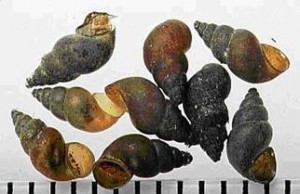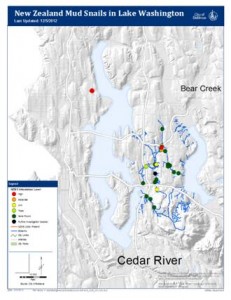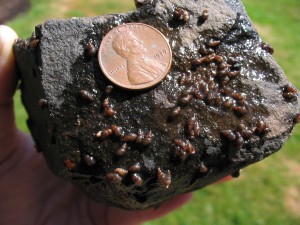The New Zealand mud snail (Potamopyrgus antipodarum) is spreading in the Pacific Northwest. This highly invasive species is invading new waterbodies, and may be getting help from field researchers who unwittingly carry it to new streams and rivers on their gear.
How do I spot it?
The mature New Zealand mud snail (NZMS) is very small, typically three to six mm long (⅛ of an inch), with an elongated shell and whorls leaning to the right (dextral). The shells usually have five to eight whorls and are light to dark brown, sometimes grey. The operculum (the round plate sealing the mouth of the shell) is thin, covers the oval opening and is only noticeable on live snails. Found in both freshwater and brackish environments, this nocturnal grazer is also known as Potamopyrgus jenkinsi or Hydrobia jenkinsi.
Compared to native snails, NZMS shells are typically narrower, longer and have more whorls. Another distinction is that these invasives are live bearers and release embryos rather than eggs. The presence of newly released live young may thus mean an infestation, though there are a few native live-bearing snails in the western U.S. (Tryonia, Eremopyrgus and Melanoides).
How did the invader get here?
The NZMS is native to streams and lakes in New Zealand and has naturalized in Australia and Europe. Experts believe that the populations found in the North American West were introduced via rainbow trout eggs from New Zealand or Australia. This invasive snail is now found in ten western states and Canada.
In the Puget Sound region, NZMS were discovered in Capitol Lake in Olympia in 2009 and have now infested Valley and Kelsey Creeks near Bellevue, Thornton Creek near Matthews Beach on Lake Washington, and the lake itself (see figure 1). The NZMS is found throughout western Oregon, and in several Central and Eastern Oregon rivers.
The NZMS is considered a prohibited species in Washington but is not classified in Oregon, where live snails cannot be possessed, imported, purchased, sold, or exchanged without a state permit. Idaho requires a permit for any wildlife or wildlife eggs but NZMS are not specifically regulated.
Why is the snail a problem?
Because of its size and successful survival strategies, NZMS populations can explode to problematic densities quickly. Some infested streams in North America have reached up to ¾ million mud snails per square meter! Domestic water supplies can be harmed by the buildup of NZMS — Australia has had issues with snails emerging from water taps. In some western streams, densities of 300,000 snails per square meter alter the nitrogen and carbon flows in a system and consume huge quantities of food.
The NZMS feeds on dead and dying plant and animal material, algae and bacteria. When present in these numbers, the snails can reduce the biomass needed to support a healthy ecosystem and can out-compete and displace native invertebrates. A Corps of Engineers article notes that the listing of five native mollusks as endangered in the Snake River is partly due to this invasive snail. And the invertebrates salmonids prefer — mayflies, stoneflies, caddisflies and chironomids – appear to be less prevalent where NZMS densities are high.
How is the NZMS able to reach these densities?
Like many invasive species, this snail is an amazing adaptor. It is not picky about habitat. It likes littoral zones of lakes and streams and can tolerate siltation and high flow as it digs into sediment. From eutrophic lakes, ponds, streams, lagoons, brackish estuaries and ditches full of silt, sand, mud, concrete or plants, to clear running water with a rocky, cobble or gravel bottom, the NZMS thrives. It can tolerate temperatures from 28°C to near freezing and salinity as high as 30-35 ppt for short periods of time.
A true survivor, the snail can pass through the digestive tracts of many fish unharmed, thanks to its operculum. That feature also allows the NZMS to survive for two or more days out of the water, a key factor in its spread.
The snail’s reproduction is also highly efficient. In the western U.S, the most common mode of NZMS reproduction is from triploid, parthenogenetic females. These are asexual females born with developing embryos in their reproductive system. This means that it only takes one snail to start a new NZMS population.
A mature female is able to brood from 10 to 90 embryos and can produce throughout the year. A female can produce up to 230 young per year and NZMS females can reach maturity at just three to six months old.
How can the snails be controlled?
Killing the snails is very difficult once they are released into the environment. Extreme heat or dryness and/or a hard freeze can kill them, although they can withstand short periods of desiccation, especially in moist conditions. There are no current control measures; the trematode from New Zealand is a potential biological control but much more research is needed.
How does it spread?
Since the snail can survive out of water, it can “hitchhike” on recreational equipment and field gear. Thus fishers, boaters, researchers and others can unintentionally introduce the snail to new rivers and streams. The snail can also travel between waterbodies on the fur and feet of wild and domestic animals.
What can I do to stop the spread of NZMS?
We need your help! Many of the new infestations in King County are thought to have been caused by biologists and others via their field gear. The best way to control the spread of the NZMS is to keep them from entering a water body in the first place. Follow these protocols:
- Know which streams and lakes are infested and stay out of them.
- Do not go from one stream or lake into another without decontaminating your gear.
- If you have to enter infected water bodies, use gear for those streams that you do not use anywhere else.
- Rinse and inspect boots and field gear and/or clean with a stiff brush before leaving a site to make sure all traces of mud and sand are removed. Don’t forget laces and insoles.
- Dry your boots, waders and other field gear for 48 hours to remove all traces of dampness before using them again. Or wash the gear in hot water (140 degrees F for five minutes) or freeze it overnight.
- Clean, drain and dry any watercraft after use.
- When cleaning fish from infested waters, make sure the internal organs are disposed of in a manner that will not bring them in contact with clean water.
- Remember: mud, sand, plant fragments and gravel on your gear are all signs that mud snails could be hiding in your boots, nets, boats or trailers.
- Keep your dogs out of infected bodies of water.
- Spread the word to your colleagues about where the snails are found and what they can do to stop spreading them.
If you think you have found NZMS in Washington, call the Washington Invasive Species Council to verify it (1-877-9-INFEST) or report online at http://www.invasivespecies.wa.gov/report.shtml. In Oregon, call 1-866-INVADER to report your sighting.
Visit any of these sites for more information on the New Zealand Mud Snail:
http://wdfw.wa.gov/ais/
http://www.anstaskforce.gov/spoc/nzms.php
http://www.aquaticnuisance.org/fact-sheets/new-zealand-mudsnail
http://nas.er.usgs.gov/queries/factsheet.aspx?SpeciesID=1008
http://el.erdc.usace.army.mil/ansrp/potamopyrgus_antipodarum.pdf
http://www.issg.org/database/species/ecology.asp?si=449&fr=1&sts
http://www.clr.pdx.edu/projects/ans/nzms.php
http://wildlife.state.co.us/WILDLIFESPECIES/PROFILES/INVASIVESPECIES/Pages/NewZealandMudsnail.aspx














